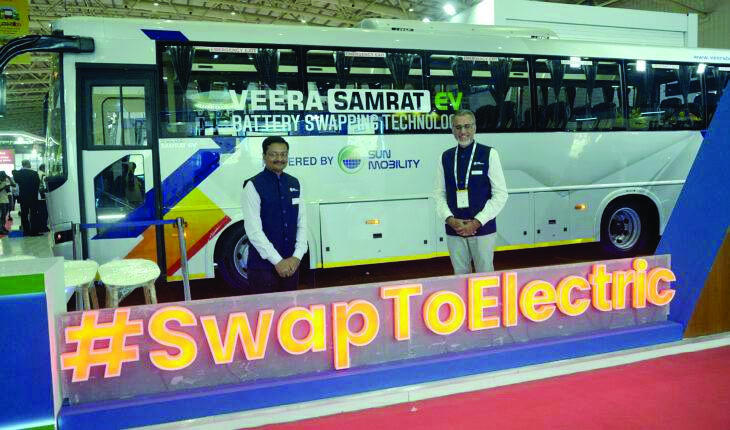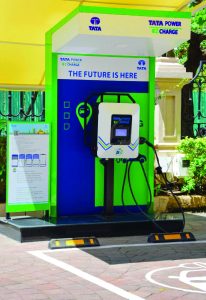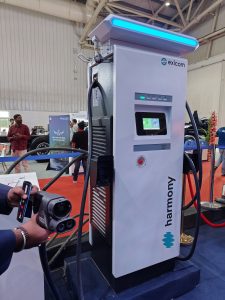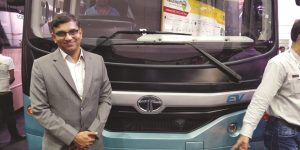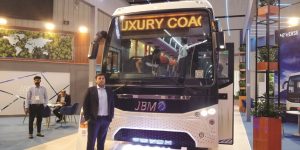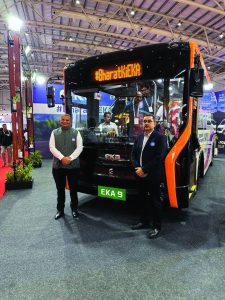With a growing focus on sustainable public transport, the ROLE OF THE ecosystem AS A KEY ENABLER IS UNDENIABLE, write Upendra Kasbekar and Richa Tyagi.
As cities across India grapple with rising pollution levels and the urgent need for cleaner mobility options, e-buses and e-coaches have emerged as game-changers. These Battery Electric Vehicles (BEVs) offer a sustainable alternative to traditional fossil-fuel-powered buses, contributing to reduced greenhouse gas emissions as they make cities more breathable. The Indian government’s initiatives, such as the Faster Adoption and Manufacturing of Electric Vehicles (FAME) and PLI scheme have so far reinforced the push towards electrifying public transport. With substantial investments in the ecosystem and incentivisation, the landscape for e-mobility in India is evolving as a success story. “India is at the cusp of a significant transition towards electric mobility, especially in the public transport space. Our electric buses are already contributing to the reduction of carbon emissions, and we aim to scale this impact further with products that suit both metropolitan and regional needs,” said Shailesh Chandra, M.D. of Tata Motors Passenger Vehicles Ltd and President, SIAM.
Several key players in the industry recently showcased their latest e-bus and e-coach models and the infrastructure to make up the ecosystem. Demonstrating advanced technology, innovative designs, and commitment to sustainability, OEMs like Tata Motors, VECV, JBM Group, Eka Mobility, Ashok Leyland, and bodybuilders like Veera Vahana Udyog with able partners in Sun Mobility presented their latest offerings. From CCS charging stations to battery-swapping technology. Improved battery management, guarantees, and charging infrastructure solutions coupled with enhanced passenger comfort and performance parity were all presented.
The changing landscape
E-buses and e-coaches represent a significant shift in the landscape of public transportation, embodying a sustainable and innovative approach to urban mobility. Both types of vehicles are equipped with advanced electric drivetrains and hint at the ecosystem evolving beyond intracity to intercity solutions. The effort to minimise the carbon footprint while lowering per kilometre operational costs is evident.
EVs typically have fewer moving parts than their Internal Combustion Engine (ICE) counterparts, resulting in reduced maintenance needs and longer life spans as the underlying proposition. Moreover, electricity is often cheaper than diesel fuel, translating to lower operational costs for operators over the life cycle despite high acquisition costs. Over time, these savings can add up, making e-buses and e-coaches economically attractive options for public transport agencies and private operators alike. Transporters have shown a willingness to upgrade if all the metrics point towards a business case.
Enhanced passenger comfort is another key advantage of e-buses and e-coaches. These vehicles are designed with modern amenities that prioritise user experience. Many e-buses feature quieter rides due to the absence of engine noise, leading to a more pleasant journey. Additionally, e-coaches showcased recently are equipped with comfortable seating, Wi-Fi connectivity, and other conveniences that appeal to passengers, especially for longer intercity trips. This hints at the supplier ecosystem contributing a great deal to the OEM and the aftermarket aligning with the growing vehicle parc.
However, challenges remain in scaling up the adoption of EVs across the country. Key obstacles include the need for strong charging infrastructure, initial investment costs, and concerns regarding the range and performance of EVs. Suresh Chettiar, Business Head – Eicher Electric Buses (VECV), said “While the adoption of electric vehicles presents its own set of challenges, especially in terms of infrastructure and upfront costs, we are confident that continued innovation, collaboration, and government support will help scale EV deployment across India. The future of sustainable transport lies in overcoming these obstacles and making electric mobility more accessible to all.” Despite these hurdles, the enthusiasm demonstrated by stakeholders of the ecosystem indicates a strong commitment to overcoming these challenges and advancing the e-mobility agenda in India.
Key OEMs in the EV business
Tata Motors unveiled the new Tata Ultra EV 7M, a seven-meter electric minibus capable of seating 21 passengers and is designed for intra-city zero-emission mass mobility. It is powered by a 213kW electric motor and an IP67-rated 200kWh Li-ion battery. It offers a range of up to 160 km in a single charge and comes with fast charging capability, enabling a full charge in just 2.5 hours. Tata Motors showcased an array of mass mobility solutions, reinforcing its position in the e-bus market with over 2,900 e-buses deployed across the country. The Tata Magna EV stands out with its full-electric drivetrain that achieves zero emissions while offering a high range of up to 280 km on a single charge. It is claimed to enhance efficiency using regenerative braking. The Tata Magna EV with a seating capacity for 44 passengers excluding the driver and co-driver. It has a fast charging capability of just 2.5 hours. To support buses, Tata Motors is actively developing an ecosystem to support its electric and hydrogen fuel cell buses, furthering its commitment to sustainable transport solutions in India. By offering a diverse range of alternate fuel-powered vehicles, the company aims to reduce operational costs and boost profitability for fleet operators. Additionally, Tata Motors has integrated its Fleet Edge platform, a connected vehicle solution that utilizes smart technologies to enhance fleet management, improve vehicle uptime, and ensure greater safety, showcasing its comprehensive approach to future mobility. Anand S, V.P. and Head of Commercial Passenger Vehicle Business at Tata Motors stated, “At Tata Motors, we are not just focused on delivering electric and hydrogen fuel cell buses but on creating a complete ecosystem that drives profitability and efficiency for our customers. Our diverse range of alternate fuel-powered vehicles, combined with innovations like the Fleet Edge connected platform, ensures operators benefit from lower operational costs, enhanced safety, and smarter fleet management. As we advance hydrogen and electric transport solutions, we’re committed to supporting India’s transition to cleaner, more sustainable mobility.”
VE Commercial Vehicles Ltd. showcased the electric Eicher Skyline Pro-E the 13.5 m Intercity coach. The Eicher Skyline Pro-E represents a significant advancement in e-coach technology, designed for intercity travel with a monocoque platform that prioritises passenger comfort. Equipped with a silent driveline, the Eicher Skyline Pro-E offers an aesthetically designed saloon area featuring plush ergonomic seats and automatic temperature control, ensuring a luxurious travel experience. This electric coach epitomises VECV’s commitment to sustainability, contributing to cleaner urban air and enhanced comfort with advanced climate control and spacious interiors. Incorporates modern safety features and driver assistance systems. Chettiar stated “Across all product segments, from value to premium, we are continuously expanding our portfolio with unique offerings. Our investments align with India’s green mobility goals, and we have scaled our capacity to meet the growing demand for efficient, sustainable public transport solutions.”
JBM Auto introduced its E12 Galaxy electric coach, a vehicle designed to revolutionise urban mobility. This coach, measuring 12.4m is built on a high-strength monocoque chassis, and emphasises passenger comfort and accessibility. It boasts a spacious interior that can accommodate 45 passengers, equipped with luxury reclining seats, and USB charging ports. The HVAC system assures a comforting ride and minimum drain on the battery pack. The E12 Galaxy is powered by a Permanent Magnet Synchronous Motor (PMSM), delivering 250 kW of power and enabling speeds of up to 95 km/h. Its 200 kWh Lithium-Ion battery supports fast charging via a CCS-2 system, achieving a full charge in 60-90 minutes. Additionally, the regenerative braking system enhances energy efficiency, contributing to lower operational costs. Nishant Arya, Vice Chairman and MD of JBM Group, recently highlighted the company’s commitment to sustainability and electric mobility, particularly through its flagship electric coach, the E12 Galaxy. He emphasised that JBM is focused on creating a comprehensive EV ecosystem called ‘JBM E-Verse,’ which integrates electric vehicles, battery technology, charging infrastructure, and power electronics to support various geographies globally. He also reiterated JBM’s ambition to lead the way in decarbonising city and intercity transportation, with the company aligning its efforts with their Net Zero 2040 goals.
Safety is a primary focus for the E12 Galaxy, which includes All-disc brakes with an Electronic Braking System (EBS), an Anti-lock Braking System (ABS), and a Fire Detection and Suppression System (FDSS). Driver Comfort and Assistance Equipped with advanced driver assistance systems (ADAS), electronically controlled air suspension, and adjustable seating to ensure a comfortable driving experience prioritising passenger and driver safety.
Eka Mobility showcased its innovative EKA 9 e-bus, emphasising intelligent design and sustainable practices. The EKA 9 is powered by a 200 kWh Lithium Ferrous Phosphate (LFP) battery, providing a reliable and efficient energy source. Its electric drivetrain delivers 213 kW of power and an impressive torque of 2,352 Nm, optimising performance for urban transit. Designed with passenger comfort in mind, the EKA 9 features an ergonomically designed centre console and Electronically Controlled Air Suspension (ECAS) for a smooth ride. The factory-fitted air conditioning system, complete with demister and bacterial filtration, ensures a clean and pleasant environment for passengers. Safety is paramount, with the EKA 9 incorporating features such as short circuit protection, over-temperature protection, and lightning protection. Operators can monitor performance, battery health, and route efficiency in real time, allowing for effective fleet management.
Battery swapping technology
SUN Mobility and Veera Vahana showcased India’s first modular battery-swapping technology for Heavy Commercial Vehicles. Now SUN Mobility and Veera Vahana, based in Bengaluru, showcased and claimed to be India’s first 10.5m battery-swappable buses for intercity and suburban routes. The same technology will work with all the vehicles of Veera Vahana. SUN Mobility has successfully onboarded over 26,000 vehicles across various segments, including two-wheelers, three-wheelers, and small four-wheelers. With a robust network of “more than 630 battery swapping stations across the country,” SUN Mobility has facilitated approximately 1.6 million kilometres and 60,000 battery swaps each day.
A significant development in the company’s growth trajectory is its strategic joint venture with IndianOil, which enables SUN Mobility to leverage a network of 37,000 fuel stations nationwide. This collaboration aims to streamline the EV customer experience by offering Battery as a Service (BaaS) across India, effectively alleviating concerns related to battery costs, obsolescence, maintenance, replacement, and charging times. According to Ashok Agarwal, CEO, of SUN Mobility, battery swapping is projected to “bring down the upfront cost of the buses by 40 per cent, matching the upfront cost of traditional internal combustion engine (ICE) buses.” This reduction, combined with improved access to financing, is expected to lower entry barriers for fleet owners looking to adopt EVs. Additionally, the battery-swapping process enhances operational efficiency for fleet operators, reducing their operational costs by up to 20 per cent. The quick swapping process, which takes less than three minutes, is claimed to maximise uptime and asset utilisation. The compact and lightweight design of the batteries also ensures higher payload capacities.
Despite their crucial role in transportation, buses and trucks account for only about 5 per cent of the total vehicle population, yet they contribute to approximately 50 per cent of tailpipe emissions. With 90 per cent of the commercial vehicles segment being privately owned and without subsidies, SUN Mobility emphasises that battery swapping can facilitate a further “30 per cent increase in EV adoption,” playing a vital role in achieving India’s ambitious goal of zero carbon emissions in the heavy commercial vehicle sector as per Agarwal.
Veera showcased its latest offerings at the event, including the Veera MahaSamrat 13.5m E-coach and Veera Samrat 10.5m E-bus, both designed to cater to the growing demand for BEVs. Veera MahaSamrat offers a peak rated power of 300 kW and a torque of 3100 Nm to counter fossil fuel options in the segment. Its advanced battery capacity of 320 kWh allows for a rapid charging time of just 15 minutes with Exponent Energy’s one MegaWatt charging network, highlighting the company’s focus on minimising downtime. The vehicle, a monocoque architecture, aims to provide a competitive edge in urban mobility while ensuring comfort and efficiency.
Challenges and future prospects
One of the primary hurdles is the need for adequate infrastructure. Charging stations are sparse, particularly in rural and semi-urban areas, making it difficult for operators to deploy e-buses effectively. Furthermore, the existing electric grid in many regions is not equipped to handle the increased demand for electricity that widespread e-bus adoption would entail. Upgrading the infrastructure to support efficient charging and maintenance will require further and ongoing investment and meticulous planning.
Another challenge is battery technology. Although advancements have been made in lithium-ion batteries, battery life, range, and cost issues persist. The performance of e-buses is often impacted by the weight of the batteries and the varying conditions in which they operate, such as temperature extremes. Additionally, the high upfront cost of e-buses, which can be two to three times more than conventional buses, poses a barrier to entry for many transport operators. While operational costs are lower over time, the initial investment can deter stakeholders, especially in a price-sensitive market as per Rohit Shrivastav, chief growth officer, EKA Mobility.
Moreover, innovations in battery technology, including the development of solid-state batteries and fast-charging solutions, are expected to enhance performance and reduce costs. Collaborative efforts among industry stakeholders, including manufacturers, technology providers, and public transport agencies, will also play a crucial role in addressing infrastructure challenges.



